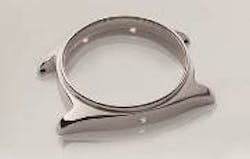EOS introduces new biocompatible metals for additive manufacturing
Krailling, Germany – EOS has expanded its metal materials portfolio for additive manufacturing with the addition of EOS titanium Ti64ELI and EOS stainless steel 316L.
“A broader variety of titanium and stainless steel materials mirrors the ever-changing requirements among our customers and opens up new fields of application,” said Christiane Krempl, product marketing manager, metals at EOS.
Between them, the metals have applications across a range of industries, including medicine, aerospace, shipbuilding, and even jewelry and watchmaking.
EOS titanium Ti64ELI
Parts built in EOS Titanium Ti64 have a chemical composition and mechanical properties corresponding to ASTM F136. Providing a high-detail resolution, this alloy can be processed on an EOSINT M 280 (400 W) metal laser sintering system and shows excellent corrosion resistance. Due to its biocompatibility and high grade of purity, it is particularly suited for the additive manufacturing of medical implants.
EOS stainless steel 316L
This stainless-steel alloy has been optimized specifically for processing on the EOSINT M 280 metal laser sintering system. It shows a good corrosion resistance and a high ductility. Parts built from EOS stainless steel 316L have a chemical composition corresponding to ASTM F138 (“Standard specification for wrought 18Cr-14Ni-2.5Mo stainless steel bar and wire for surgical implants UNS S31673”). In the medical industry, this alloy is particularly suited for surgical instruments, endoscopic surgery, orthopedics, and implants.
The material is also a good choice for use in the watch and jewelry industries, where the designer benefits from extensive freedom of design. Shaping and structural restrictions as such are a thing of the past. Parts such as watch cases (thanks to defined hollow spaces) can be manufactured more cost efficiently and easily, saving resources (see photo).
The material is also well suited for additive manufacturing applications such as spectacle frames or functional elements in yachts. In the aerospace industry, EOS stainless steel is a good choice for the manufacture of clamping elements or heat exchangers. Parts manufactured from that material can be mechanically post-processed or polished.
----
Related from 10/17/2013: EOS adds to range of additive manufacturing metals and plastics
----
Photo: A laser-sintered stainless steel watch case.
